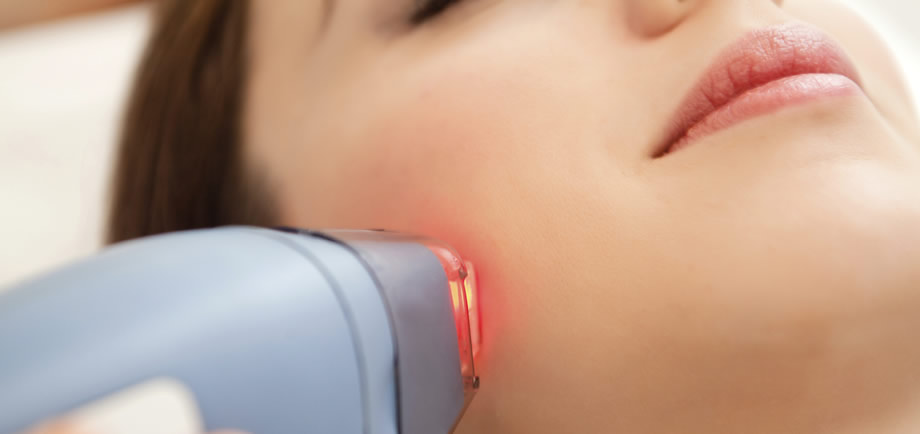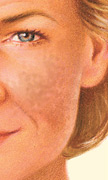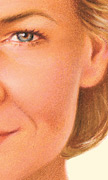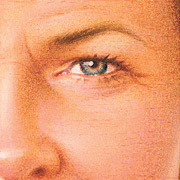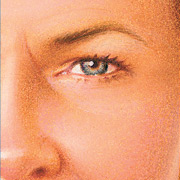Laser and light treatments resurface the skin to treat pigmentation disorders, such as sun and age spots.
Laser resurfacing can improve fine lines and wrinkles of the entire face, or in specific regions of the face, such as the upper lip and around the eyes.
A series of treatments are required to achieve improvement in skin texture and clarity and repeated treatments are essential to maintain your results.
What Is Laser Resurfacing?
In laser resurfacing, sometimes called “laser peel,” a carbon dioxide (CO2) laser is used to remove areas of damaged or wrinkled skin, layer by layer. Laser resurfacing is performed using a beam of laser energy which vaporizes the upper layers of damaged skin at specific and controlled levels of penetration. Laser resurfacing is still a very new procedure. Often, the procedure is done in conjunction with another cosmetic operation, such as a facelift or eyelid surgery.
Laser Skin Resurfacing Treatment Areas
Laser resurfacing may be performed on the whole face or in specific regions. The procedure is most commonly used to minimize the appearance of fine lines, especially around the mouth and the eyes. However, it is also effective in treating facial scars or areas of uneven pigmentation.
How Does Laser Resurfacing Work?
All resurfacing treatments work essentially the same way. First, the outer layers of damaged skin are stripped away. Then, as new cells form during the healing process, a smoother, tighter, younger-looking skin surface appears.
Advantages Of Laser Resurfacing
It’s clear that laser resurfacing may offer a number of advantages over other resurfacing methods: precision, little (if any) bleeding and less post-operative discomfort.
For superficial or medium resurfacing, the laser can be limited to the epidermis and papillary dermis. For deeper resurfacing, the upper levels of the reticulas dermis can also be removed. Varied penetration allows treatment of specific spots or wrinkles.
It’s also important to consider the length of recovery when choosing among the skin-resurfacing alternatives. In general, the more aggressive the resurfacing procedure is, the more prolonged the recovery is likely to be. “Light” resurfacing procedures, such as superficial chemical peels or superficial laser resurfacing, offer shorter recovery times. However, these lighter procedures may need to be repeated multiple times to achieve results comparable to those achieved with more aggressive techniques.
Whos Is A Good Candidate For Laser Resurfacing?
In many cases, facial wrinkles form in localized areas, such as near the eyes or around the mouth. The laser can be precisely controlled so that only these specific areas are targeted.
Patients with olive skin, brown skin or black skin may be at increased risk for pigmentation changes no matter what type of resurfacing method is recommended. Your plastic surgeon will evaluate your skin characteristics and make recommendations accordingly.
Also, individuals who have taken accutane in the past 12-18 months or are prone to abnormal (keloid-like) scarring or those with active skin infections on the treatment area may not be appropriate candidates for this procedure.
Remember, having laser resurfacing can help enhance your appearance and your self-confidence, but it won’t completely remove all facial flaws or prevent you from aging. Lines that occur as a result of natural movements of the face – smiling, squinting, blinking, talking, chewing – will inevitably recur. Your plastic surgeon can suggest ways to help you preserve your results by protecting yourself from sun exposure or using maintenance treatments, such as light chemical peels or medicated facial creams. Before you decide to have laser resurfacing, think carefully about your expectations and discuss them with your surgeon.
Preparing For The Laser Resurfacing Procedure
Depending on your individual needs, your surgeon may recommend that you begin a pre-treatment plan to prepare the skin for resurfacing.
At the time of the procedure, you will be given specific instructions on how to care for your skin immediately following your laser treatment. Your surgeon may also instruct you to follow a specific maintenance regimen for long-term care of the skin to maximize the benefits of the procedure.
While you are making plans, be sure to make arrangements for someone to drive you home if you will be given tranquilizers or sedation for your laser treatment.
The Laser Skin Resurfacing Procedure
Laser resurfacing is a relatively quick procedure. It usually takes anywhere from a few minutes to 1 1/2 hours, depending on how large of an area is involved.
When the imperfections are especially deep, your surgeon may recommend that the resurfacing be performed in two or more stages.
During the procedure, the activated laser is carefully passed back and forth over the skin until the surgeon reaches the level that will make the wrinkle or scar less visible.
When the procedure is over, your surgeon may choose to treat the resurfaced skin with applications of protective creams or ointments until healing is complete. Some surgeons choose to apply a bandage over the treated areas which will cover and protect the healing skin for the first five to ten days.
Where Your Laser Treatment Will Be Performed
Laser resurfacing may be performed in a hospital, an outpatient surgery center or a surgeon’s office-based facility. For cost containment and convenience, laser resurfacing is usually done on an outpatient basis. For the more extensive resurfacing procedures or for resurfacing combined with other surgical procedures, you may be admitted to a hospital or a recovery center.
Types of Anesthesia Used With Laser Resurfacing
Laser resurfacing is most commonly performed under local anesthesia with sedation, especially when it’s used to treat localized areas of the face. You’ll be awake but relaxed, and will feel minimal discomfort. For more extensive resurfacing, your surgeon may prefer to use general anesthesia, in which case you’ll sleep through the procedure.
Laser Resurfacing Recovery
You are likely to experience some mild swelling and discomfort after laser resurfacing. However, this can be controlled with ice packs and medications prescribed by your surgeon.
If a bandage was applied after your procedure, it may be replaced with a fresh one after a day or two. After about a week or so, your bandage will be removed and a thin layer of ointment may be applied to the skin. Once this stage is reached, your surgeon will provide instructions on how to gently wash and care for your healing skin.
During this phase of healing, it is very important that you not pick the crusts off the treated area or scarring may result. Most patients are free of crusts by about 10 days post-operatively. Redness may persist for several weeks.
What To Expect After Laser Skin Resurfacing
Your new skin will usually remain bright pink to red in the weeks following the procedure. Your surgeon may prescribe medications to make this color subside more rapidly. After about two weeks or so, most patients can safely apply makeup to conceal this temporary color change. However, some pinkness may remain for up to six months.
It is rare, some patients may find that their healing skin is unusually sensitive to the makeup that was regularly used prior to treatment. In such instances, makeup should be avoided until a substitute can be found or until the healing progresses to a point at which the makeup no longer causes a reaction.
Above all, in the months following treatment, it’s important to protect the treated area from the sun until all the color has returned to normal. Using sun protection regularly will help to maintain your results and reduce the chance of any new sun damage to your skin.
If you must be in the sun, apply a strong sun block with an SPF of 15 or higher and shade your face with a hat or visor. If resurfacing was performed around the eyes, it’s best to also wear good quality sunglasses with UVA and UVB 100 percent filters.
Results Of Laser Resurfacing
The final result from laser resurfacing may take several months to fully appear. However, once the pinkness fades, patients usually notice a significant improvement in the quality of their skin and a fresher, smoother appearance.
It’s important to understand that your results will be long-lasting, but not permanent. Remember, your new skin is not immune to the effects of aging. In the months and years following your laser treatment, your natural facial movements will eventually cause any “expression” lines to recur.
As with other methods of skin rejuvenation, laser treatments can usually be repeated. However, by protecting yourself from the sun and following a skin-care regimen recommended by your plastic surgeon, you can help maintain your rejuvenated look.
Risks Of Laser Skin Resurfacing
When laser resurfacing is performed by a qualified, experienced surgeon, complications are infrequent and usually minor. However, because individuals vary greatly in their anatomy, their physical reactions and their healing abilities, the outcome is never completely predictable.
Risks associated with laser resurfacing include: burns or other injuries from the heat of the laser energy, scarring, and obvious lightening or darkening of the treated skin. Also, laser resurfacing can activate herpes virus infections (“cold sores”) and, rarely, other types of infection.
Additional corrective measures and treatment may be required if healing seems abnormal or delayed or if there is any evidence of abnormal pigmentation or scarring.
Your surgeon will discuss your medical history, perform a routine examination and photograph the area to be treated. He or she should explain the procedure in detail, along with its risks and benefits, the recovery period and the costs.
Schedule A Consultation
To learn more about laser resurfacing, please contact our office today at (732) 219-0447 to schedule an appointment.

